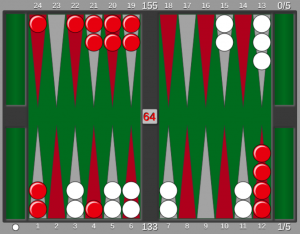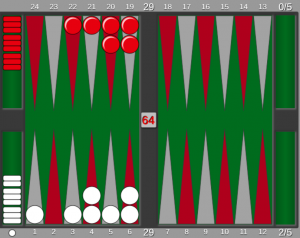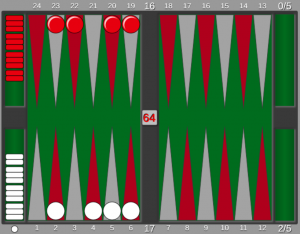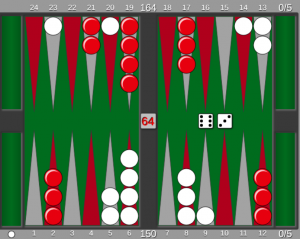We had a fair showing for our final “Tour of Patios” event of the year – 11 players came out to Breakside Dekum (which, to be fair, is more of a sidewalk than a patio). It was largely the usuals, but a couple of players who haven’t been in for a while as well – Andres (who beat me in a hard fought first round match), and Leslie (who brought her daughter, Nina, and then the random draw set them against one another!)
Anyway, with a smaller field, we only had 4 brackets run – congratulations to Julie, Bodger, Kyle, and me on the bracket wins! Julie noted that she wins just often enough to keep her sense of optimism going, which I think resonates for all of us…
I attempted to record my matches, but I “upgraded” my camera to one that I apparently don’t know how to use – almost none of the recordings are usable. In the first, which was just Dave and I doing some money games before the matches started, I literally can’t see the right-hand side of the board at all. Terrible. But, I did get close enough on my final match, against Jeremy, to be able to transcribe that (single game) match. Here are a couple of points from that one that I think are a little interesting.
First up is a cube decision that Jeremy gave me. Spoiler alert, it’s a great time for him to cube – but should I take, or drop?
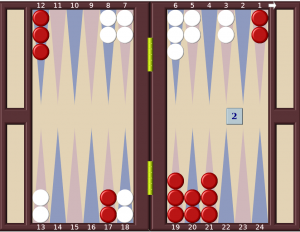
For these kinds of decisions, I like to use the “Position, Race, and Threat” analysis schema to think through it. If your opponent only has 2 out of 3, it’s probably a take. If he has all 3, it’s likely a drop. Here, Jeremy is definitely up in position, having mostly escaped his back checkers, while mine are stuck back on his ace point. He’s also up in the race, something I did not bother to check at the time, but which was obvious because he had rolled double 6’s the sequence before and we were early in the game. And threat – well, yes, he has the threat of priming my back checkers! So I should have dropped. But over the board, I did not actually use the “Position, Race, and Threat” analysis schema, I just said “oh, it’s early” and grabbed the cube to use as a weapon later on. GnuBG rates this as about a -0.152 blunder – my winning chances are good enough, but I also get gammoned a lot, and so it’s a massive drop!
And here’s the point where I decided that I had turned things around enough to offer the cube back to Jeremy – should I have doubled from here?
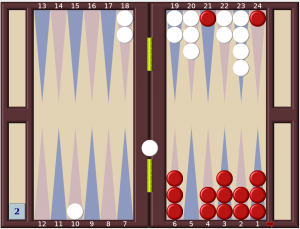
For recubes, one key thing is to know what “market losers” you have – what can you roll that would make it impossible for your opponent to take. Here, I escape with any 4, 5, or 6, and I step up my last checker off the ace point with any 3. If I happen to roll just 1’s and 2’s, well, I can safely play those in my home board. So nothing can go wrong, and most of my rolls put me in a much better position, so I figured I was good enough to take it up to a 4-cube. But I am not good enough just yet! GnuBG rates my recube as a -0.166 blunder, so slightly worse even than my take! If my back checker was also on his 4-point, or if my checker on his 4-point was up to where it could directly hit his blot in my outfield – then it would be a proper redouble. So I was premature. However, I was also lucky – Jeremy snatched up the 4-cube, but then the dice went completely in my direction and I was able to win a gammon to win the match in one game.
Anyway, it was a fun afternoon, thanks to everyone who came out. Next event is the Men’s Championship Qualifier/Women’s Championship Qualifier double-event, back at Lucky Lab, on the 27th – hope to see you all there!
-Mark
